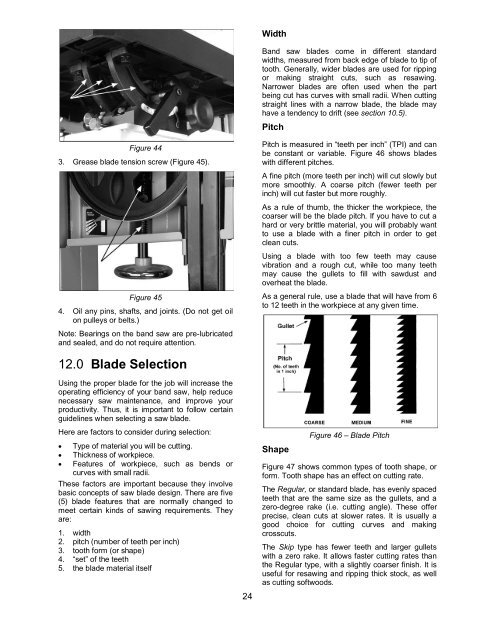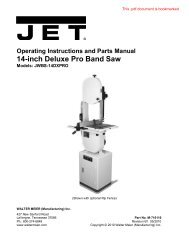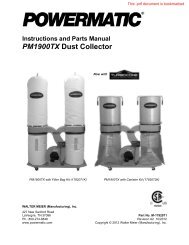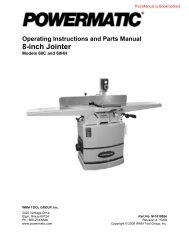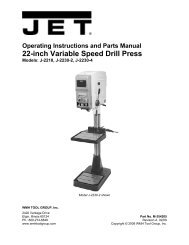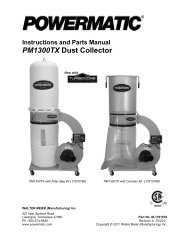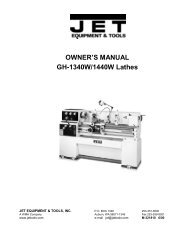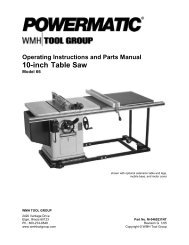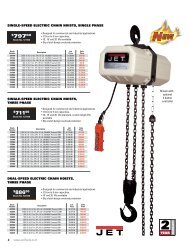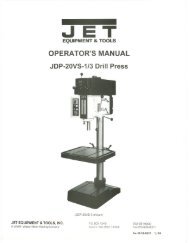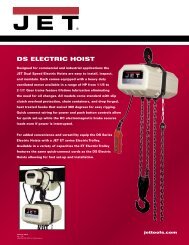You also want an ePaper? Increase the reach of your titles
YUMPU automatically turns print PDFs into web optimized ePapers that Google loves.
Figure 44<br />
3. Grease blade tension screw (Figure 45).<br />
Figure 45<br />
4. Oil any pins, shafts, and joints. (Do not get oil<br />
on pulleys or belts.)<br />
Note: Bearings on the band saw are pre-lubricated<br />
and sealed, and do not require attention.<br />
12.0 Blade Selection<br />
Using the proper blade for the job will increase the<br />
operating efficiency of your band saw, help reduce<br />
necessary saw maintenance, and improve your<br />
productivity. Thus, it is important to follow certain<br />
guidelines when selecting a saw blade.<br />
Here are factors to consider during selection:<br />
• Type of material you will be cutting.<br />
• Thickness of workpiece.<br />
• Features of workpiece, such as bends or<br />
curves with small radii.<br />
These factors are important because they involve<br />
basic concepts of saw blade design. There are five<br />
(5) blade features that are normally changed to<br />
meet certain kinds of sawing requirements. They<br />
are:<br />
1. width<br />
2. pitch (number of teeth per inch)<br />
3. tooth form (or shape)<br />
4. “set” of the teeth<br />
5. the blade material itself<br />
24<br />
Width<br />
Band saw blades come in different standard<br />
widths, measured from back edge of blade to tip of<br />
tooth. Generally, wider blades are used for ripping<br />
or making straight cuts, such as resawing.<br />
Narrower blades are often used when the part<br />
being cut has curves with small radii. When cutting<br />
straight lines with a narrow blade, the blade may<br />
have a tendency to drift (see section 10.5).<br />
Pitch<br />
Pitch is measured in “teeth per inch” (TPI) and can<br />
be constant or variable. Figure 46 shows blades<br />
with different pitches.<br />
A fine pitch (more teeth per inch) will cut slowly but<br />
more smoothly. A coarse pitch (fewer teeth per<br />
inch) will cut faster but more roughly.<br />
As a rule of thumb, the thicker the workpiece, the<br />
coarser will be the blade pitch. If you have to cut a<br />
hard or very brittle material, you will probably want<br />
to use a blade with a finer pitch in order to get<br />
clean cuts.<br />
Using a blade with too few teeth may cause<br />
vibration and a rough cut, while too many teeth<br />
may cause the gullets to fill with sawdust and<br />
overheat the blade.<br />
As a general rule, use a blade that will have from 6<br />
to 12 teeth in the workpiece at any given time.<br />
Shape<br />
Figure 46 – Blade Pitch<br />
Figure 47 shows common types of tooth shape, or<br />
form. Tooth shape has an effect on cutting rate.<br />
The Regular, or standard blade, has evenly spaced<br />
teeth that are the same size as the gullets, and a<br />
zero-degree rake (i.e. cutting angle). These offer<br />
precise, clean cuts at slower rates. It is usually a<br />
good choice for cutting curves and making<br />
crosscuts.<br />
The Skip type has fewer teeth and larger gullets<br />
with a zero rake. It allows faster cutting rates than<br />
the Regular type, with a slightly coarser finish. It is<br />
useful for resawing and ripping thick stock, as well<br />
as cutting softwoods.


